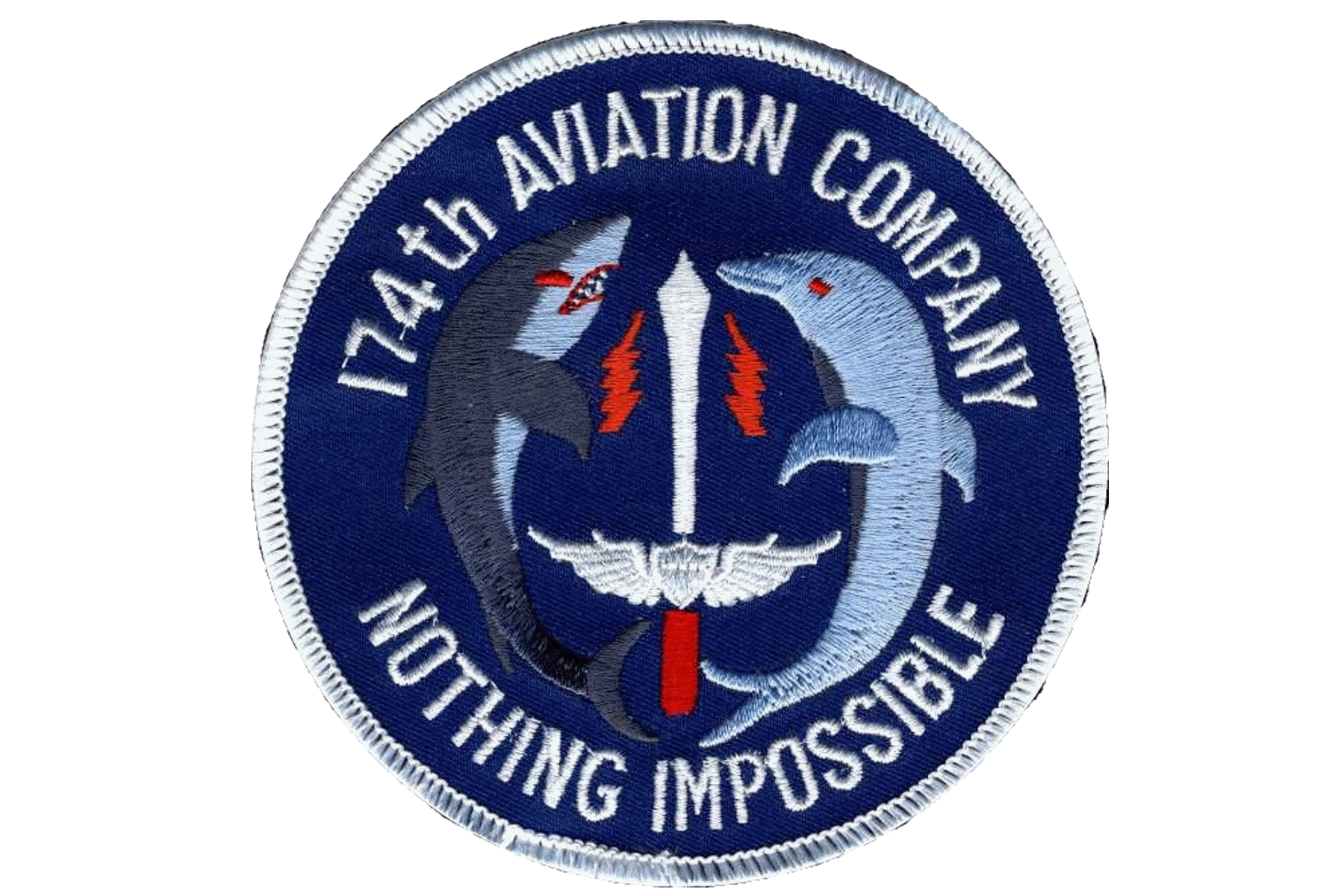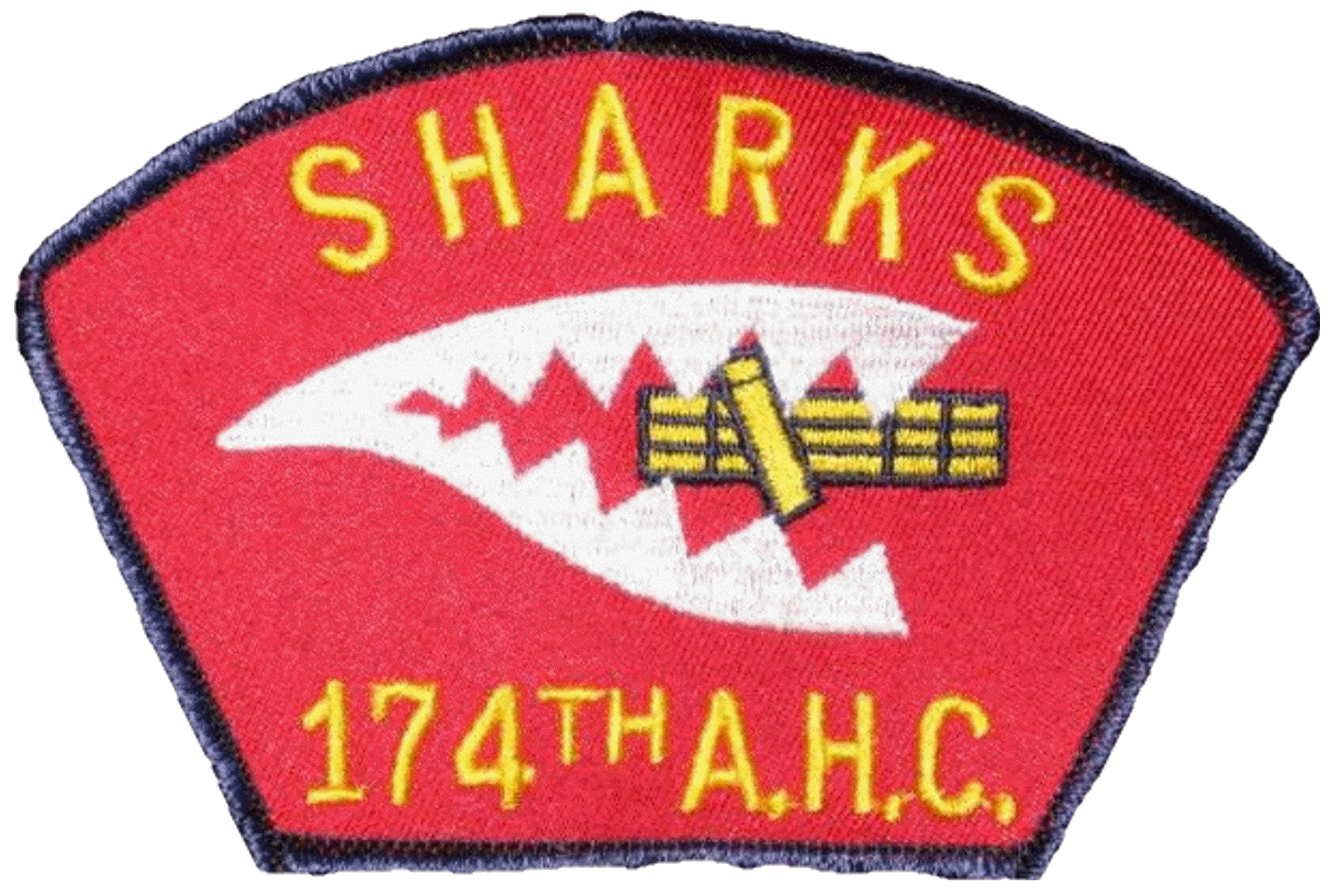...Finally I was assigned to
the Sharks.
This was all right! I LIKE flying close to the ground. I always knew I was
afraid of heights. Flying in the Sharks was some of the most interesting flying I had been involved
in. The Sharks used UH-1C Charlie models like Loaches, flying low and slow... getting right down
there with the Grunts. Of course this did have its drawbacks...
While were covering
a Dolphin spray mission (can you say "Agent Orange?") west of San Juan Hill, and as the Dolphin
was making its spray runs, our ship started taking fire from the right. Jeff Zavalas was the AC.
Before we could make a turn to return the favor, our wing ship told us we were leaking fuel. The fuel
gauge was dropping like the Titanic. A quick check out the door confirmed we had a problem. There
was fuel streaming down the right side of the aircraft onto and over the right side rocket pods. The
fuel was flowing at approximately the same rate as Niagara Falls. Since the mission was close to the
Special Forces camp at Ba-To, we headed that direction, hopefully before the ship ran out of fuel.
Once at the Special Forces camp, the ship was shut down and it was determined that a round had
cut a fuel line in the engine compartment. I bet that would have been some sight if we hadn't been
told about our leak and we touched off a rocket or two. As it turned out, we got another free ride
home by the 178th.
The Happy Valley area was always a good place to troll for
something to kill. Flying low and slow, the ship turned sharply. On this particular flight, I thought
we had a tailrotor failure as the old Charlie Model REALLY banked over hard. I looked to the
right and saw that Scott Sparks was leaning out the right cargo door and was holding onto the
door itself. The door hadn't securely latched, worked its way forward, and the wind pushed it out
where it was caught by the minigun mount and frame, causing a large, one-sided airbrake. The
ship was pulled to a hover, and as Scott and I got the door secured, some enterprising NVA/VC
took a shot at us. We were in no position to return fire. Luckily, the only damage we suffered from
this was the bent cargo door, which was replaced.
Speaking of the Happy Valley,
this is the only time that I know of where a Shark aircraft was used to medivac a wounded ARVN.
A Dustoff was sent to the area and the Sharks were requested to provide cover. The Shark team
was already in the area, but the Dustoff wasn't. Both Sharks were low on fuel. Capt. Mike Ackerman,
Shark 6, found that the unit hadn't had any recent contact. Ackerman told Dustoff that we would
make the medevac himself because of Dustoff's location and our fuel shortage. While the wing ship
covered the area of last contact, Ackerman landed and medivaced the ARVN.
Photo below: Fred Thompson, flying as Captain Ackerman's wingman, took these
photos of Shark 6 as Ackerman conducted his "Armed Dustoff Medevac."
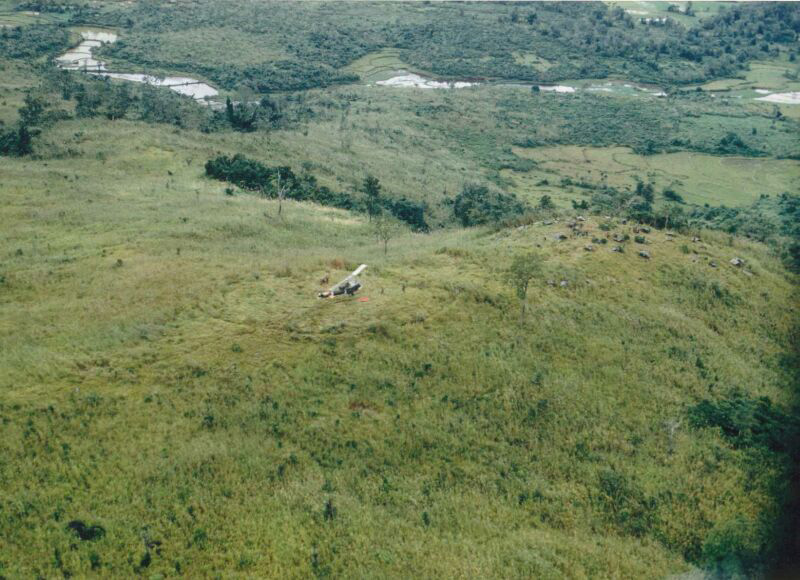
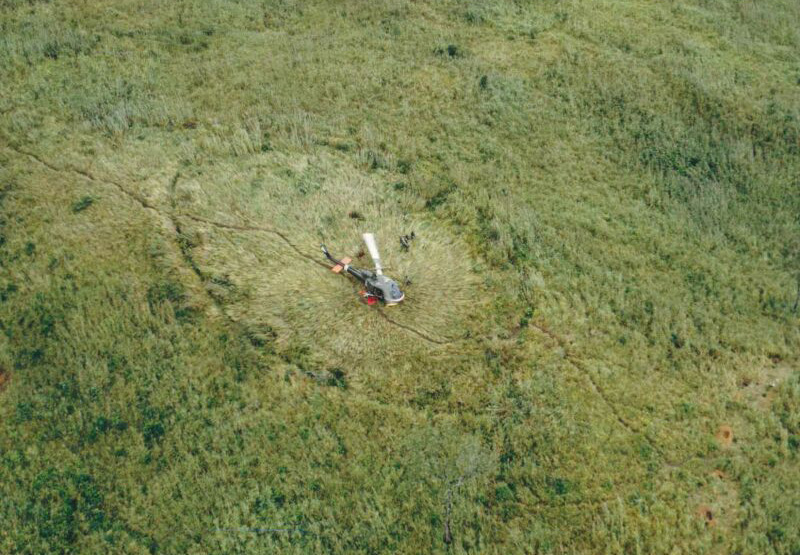
Captain Mike
Ackerman, our Platoon Leader, always radiated confidence and professionalism. He was
one of those guys that had an aura around him that--when I was flying with him--I always felt
that nothing bad would happen to me. He was flight lead flying in Shark 540 on an extraction
of Grunts from the 1/20th from the mountains NW of LZ Liz. When I walked out to the ship, prior
to the mission, he ask why I wasn't wearing a cap. I don't recall my excuse, but he told me that
when we returned from this mission, for a week, I would have to wear my flight helmet whenever
I was outside. My fate was cast. As we were covering the Dolphins making the extraction, I saw
some people moving around in the lower hills to the south of where the Grunts were being picked
up. I told Ackerman about this. As he was checking to see if there were any friendlies in that area,
he flew down to where I observed the people. We started taking fire. Well, that answered the
question of whether they were friendly or not. The extraction became an impromptu CA. At the
end of the day, Ackerman told be that I didn't have to wear my helmet as he had earlier ordered,
thanks to finding the "unfriendlies." But I did need to start wearing the cap.
Anyone
ever hear of a Lizard Dink? The lizards in Vietnam grow larger than some of the people. When in
the water, you could see where they were because they would stir up the mud on the bottom. While
working the Horseshoe area and flying over the river, we noticed that the mud was being stirred
up. "Must be a lizard." "You sure?" "Not really." So a concussion grenade was thrown in the
water, just to be sure. The ship circled waiting for the explosion, and for the unlucky lizard to
surface.
BOOM!
YIKES! I didn't know lizards had AK-47s.
After a quick burst from their AK's, they died. The three NVA/VC soldiers were found to be
paymasters, apparently delivering money to the troops. Sorry, no boom-boom for Uncle Ho this
month.
If you call getting merely wounded as lucky, then WO Jim Kinne is probably
the luckiest man I've seen when it comes to being shot. I think he was shot three times while flying
with the Sharks, two of which were in the Horseshoe. I don't recall for sure, but maybe all three
times were in the same area.
Kinne was flying in the foothills just south of the
Horseshoe. We received fire, hitting Kinne in the left hand. I'm not saying we were low but I think
the barrel of the dink's gun bounced off the skid and his brass ended up in the ship. The second
time Kinne was shot is notated in Fred Thompson's biography.
Another quiz: The
question is... Does a OH6 Loach need a pilot or crew to maneuver around a rice paddy?
The answer is... No.
On completing a mission for 3/1 and
returning to Duc Pho, from the north, there was an Air Cav unit circling one of their Loachs which
was on the ground. I don't recall if it was the Blueghost, or Warlords, or who. The Loach was in a
water-filled rice paddy sorta hovering, almost, by itself without the crew. The crew was trying to
get into the ship to get it grounded. It was a strange sight to see an OH-6 sliding around the paddy,
bouncing off the dikes like it was playing bumper cars, with no one flying it. The Crew was finally
able to get this wayward ship under control. I never did hear how the Loach went AWOL, but it had
probably been "frictioned-down" and the friction on the controls loostened up.
I was
out on the flight line one day working on Shark 540, the Grim Reaper. This particular morning, the
primary team was scrambled for a unit in contact south of Mo Duc. Both Sharks were cranked and
ready to go, but one of the ships was missing the crew chief. I went over and got into the ship, and
as we were about to lift off, the crew chief arrived. I told the crew chief, Yogi Reeves, that I would go
ahead and fly for him. He said OK. Yogi was from the Atlanta, Georgia area... the damn Rebel probably
got lost in the holler or something on the way to the helicopter. We arrived in the area of contact,
and as it was being prepped by us, I was hit in the shoulder by something. It didn't really hurt. I
reached over and touched my shoulder. It was wet and gooey. My first response was, "SHIT!" I then
looked at my hand and shoulder…MUD…When a rocket was fired and hit the dike it kicked up some
mud and we were so low that it hit my shoulder. So much for my Purple Heart!
Fred
Thompson spoke of rearm specialist Timothy Jeome "Shadow" Spencer. Well, there was another
specialist who worked in rearm also. I don't recall his name but his nickname was "Bean." Bean
was Hispanic, and was from Michigan or Minnesota. Bean would call us caucasians a "bunch of
white bananas." Both these guys did an excellent job of keeping rearm completely stocked and
helped with loading each Shark when they returned from a mission. Well, Bean wanted to fly, so
one day the Sharks were to cover an extraction for the 4/21, SW of Duc Pho in the Rice Bowl area.
This was another one of those "It's suppose to be a cold extraction" missions. Of course Murphy's
Law took over, and Bean's cold flight turned out to be a hot one. They took fire, and a round struck
the mike cord coupling on the AC's helmet, severing the coupling. This was about three feet in front
of where Bean was sitting. I think he'd had enough, as I don't recall Bean wanting to fly any more
after that.
The longest distance I flew on a scramble supporting a unit in contact was
the day a team of Sharks were sent NW of Tam Ky, where it was reported that an entire flight of the
71st AHC Rattlers had been shot down in an LZ. Tam Ky is NW of Chu Lai. The Sharks flew to Chu
Lai, refueled, then continued to the LZ.
Low leveling towards the area, we flew over
several NVA running towards the battle. We were going to engage them, but were told to continue
to the LZ. When we got to the area, I saw that the flight of three or four helicopters were sitting in the
LZ with the blades displaced and not running.
We took immense fire from the area.
My little green bugs were flying all over the place.
We exchanged fire until the bugs
went away. In addition to the AMC and other slicks in the area, there were about six to eight
gunships from the 71st Firebirds, 176th Muskets, and the Sharks. I don't recall how many times
we would return to Tam Key to refuel and rearm, but we stayed in the area until the 71st was able
to get enough people in to secure their people and aircraft.
I'll give you guys reading
this a clue. Never--mean NEVER--attempt to insert a LRRP Team into a NVA base camp! This has
some dire consequences for the crew and LRRPs. Our Shark team was covering a G Company, 75th
LRRP team insertion to the SW of San Juan Hill. We were staying out of the immediate area of the
insertion. The low Dolphin was dropping off the LRRPs when they started receiving fire, and the
Dolphin was shot down in the LZ. The AC was Lt. William Smith. You could hear the desperation in
his voice as he said they were hit and going down. We arrived in the area to cover the recovery of
the LRRPs and crew. I don't recall if the ship was recovered or not, but what really sticks in my
mind is call for help from Smith. When I was in the second platoon, I always liked the LRRP insertions
and extractions, and mainly in being the low ship. I don't know why I enjoyed these types of
missions so much, as they were certainly high risk missions.
I had flown with Lt.
Smith in the Dolphins. I think he was a Yankee from the New York area, based on his accent. He
had another mis-adventure in my old ship, Dolphin 644. I don't know if they were returning from
the 4/3 area or working the 1/20 area, but they called in a "May Day" as they were going down in
the foothills west of LZ Liz. Apparently there was a lot of strange noises coming from the
transmission area, and it was spitting out parts like shit through a goose. They did an emergency
landing, and the Sharks and Witch Doctor were sent out the cover the ship and crew. Old 644 was
rescued again by the Boxcars from the 178th ASHC and got a free ride home on the end of a rope.
Towards the end of January 1971, the 174th was told that we would be moving, but
not told where. Mouse, one of our hootch maids who had worked for our Company since I arrived
in April 1969 came up to me and said, "Taggart, you lifer, you been in Vietnam forever." I told her
"no, I'm a short timer." She said "No, you lifer, you go to Laos, you die." With that vote of confidence,
I couldn't wait to find out where the 174th was headed. Just after this, the 174th loaded up and
headed northbound, with the ultimate new base being Quang Tri, to work in Laos just like Mouse
had said. I should have talked to Mouse more about this since she seemed to be in the know of
what we would be doing. About this same time, I was talking to John Moore. As I'd been in Vietnam
since 1969, he started to laugh and told me that I would be in Vietnam longer than he would be in the
Army. I think he was jealous.
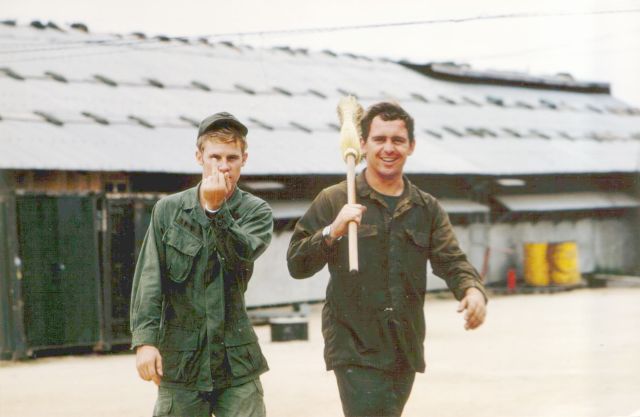
Tom is the guy with the broom. The 174th
mess hall is in the background. John (the Finger) Moore had his heal blown off in Laos. That
portion of his foot and his boot heel landed in Pat Wade's ammo can...
(Dec '70 at Duc Pho,
photo by Fred Thompson)
Once the 174th arrived
at Quang Tri, we were housed at an abandoned orphanage some distance from the flight line. This
was hard to get used to because at Duc Pho the flight line was within spitting distance of the
hootches. Most of the company, with the exception of the officers, were in the old orphanage
building. The officers were in tents around the outside of the building. Not bad, since it was in,
out of the rain.
I never thought that I would be cold in Vietnam, but it was winter,
and monsoon season, and everything stayed wet. Quang Tri was just COLD! The continual rain
made things more uncomfortable, especially when you had a hundred-mile-per-hour wind hitting
you in the face when you were flying as a crew chief or gunner on a gunship, it would chill you to
the bone.
The first few days that the Sharks flew up to Khe Sahn, it was spooky. It
was so quiet. There was no movement or contact with the NVA. I think this was more unnerving
than anything else. As the days passed, traffic on the one main road into Laos (QL9) increased, as
did the missions.
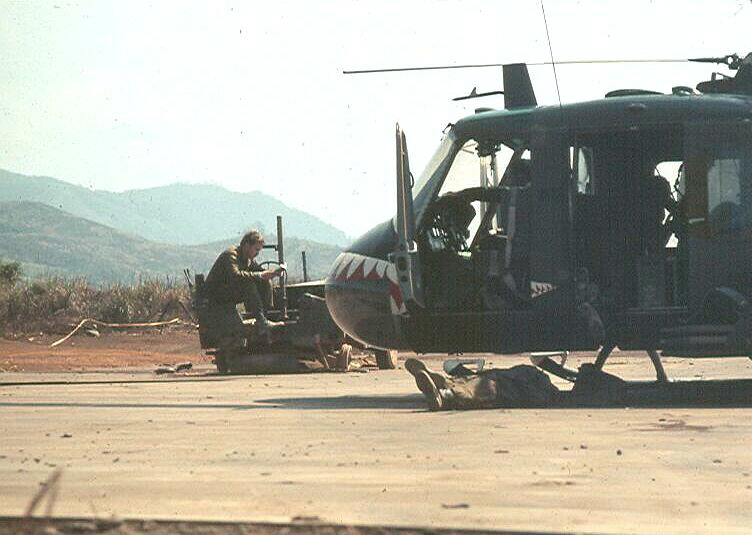
Above photo is courtesy of the late Fred Thompson. “That’s
Tagg underneath the nose of Shark #540 ‘Grim Reaper’ at Khe Sanh. Obviously a ‘lull’ in the
War.” – Fred
Then Lam Son 719--the
Ultimate Romeo Foxtrot (RF)--began.
Flying in Laos was a bit different than in Vietnam. You almost got to pick what you wanted
to be shot at with, depending on what altitude you were flying at. The Sharks began with covering
the various flights of Dolphins. To confuse the NVA listening to the frequencies (yeah, right!) our
callsign was changed to "Boats" for this operation, as well as other helicopter companies inserting
Grunts into LZ's around Khe Sahn, Vandegrift and the Rock Pile. Very soon we were flying the
ARVNs into Laos.
Photo below: "The Teeter-Totter" at Khe Sahn
(or, how to use a war zone as a playground). Sharks on standby, February 1971. Taggert is on
the left, then Bill Wilder (in air), then Gary Munson, and an unknown Shark crewman on the right
(possibly
Ray Earvin). Photo by Fred Thompson.
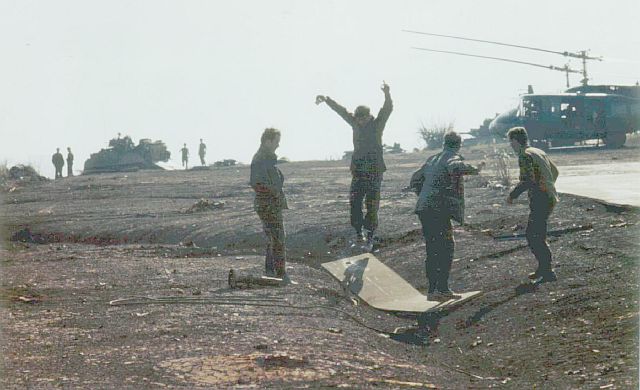
About two-three weeks later, the Sharks were assigned to Dustoff cover.
I've never seen so many aircraft of every description, both Army and Air Force, in the area at the same
time, flying in different directions. Then you had to make sure that you didn't stray into the path of
the Arc Lights (B-52 strikes). From watching both the lift ships and Dustoff aircraft, I felt sorry for the
crews that had to deal with the ARVN flights. Time and time again, as the ships would either insert
or extract the ARVNs, there would be several of the troops that wouldn't get off the ships, or would
hold onto the skids. Sometimes, on extractions, so many would climb onto the aircraft, they'd
make it almost impossible to take off. Then you would have to factor in the ground fire of every
caliber and mortars landing in the LZ or PZ. Not a pretty place to be. Because of this I'm surprised
that casualties among the aircrews wasn't higher than it was.
Fred Thompson has
documented a lot of the events of that time with the 174th in his biography, so I won't go into what
he has already covered, but will add a few incidents.
At the 174th's old AO of
southern I Corp (Duc Pho area), I had flow over and around the area so much in the last almost 2
years that you could take me out blindfolded, show me a tree, and I could practically tell you where
I was. Not so in Laos. There were several times that once in Laos, with all the yanking and banking
to get out of contact with the intense ground fire, and keeping in eye contact with the aircraft you
were covering, that the entire crew would become disoriented. And with us being so close to North
Vietnam, you couldn't simply fly east to get home. I was fortunate not to become a "criminal" like
Fred and other members of our company who actually spent time on the ground in Laos, against
Presidential Orders.
On a Dustoff cover west of either LZ Ranger North or Ranger
South, I was on a Hog ship (which has a 40mm on the nose and 19 shot rocket pods on each side).
This thing is nose heavy on a good day, and because of the weight it wasn't very responsive to
quick movements. Dustoff had picked up a load of wounded, while being bombarded by mortars,
and was climbing out. The Shark team was following Dustoff at a lower altitude, when we started to
receive fire. One of the first rounds came up through the console, taking out the armament panel.
We were unable to fire the rockets or the mike-mike (40 mm). As the ship slowly climbed we
continued to take ground fire. The only protection the ship had was our door guns, and man
were we using them.
The area could best be described as being in the bottom of
a bowl, where you would have to climb to get to the top of the bowl. A Hog ship climbs like a rock
anyway, only slower. Every time our direction would change, more ground fire was received. The
lead Shark would follow the Dustoff out, but we couldn't climb fast enough to follow. We were left
alone to work ourselves out of this predicament.
Finally, no more door guns. Ammo
expended. To lighten the load, all of the 40 mm ammo from the cargo compartment between the
crew chief and gunner was thrown out. We tried to jettison the rocket pods, but they wouldn't
manually release. Finally we were able to climb where we BARELY cleared the trees, at the top
of the mountain, by dragging the skids through the tops of the trees. On the other side of the
mountain was a large valley where we headed back to the relative safety of Khe Sahn. We were
lucky that there weren't any NVA on that mountain top or our ship wouldn't have made it back,
since the only firepower left were our personal M16's and sidearms.
Laos!
I think the powers-that-be either forgot, ignored, or lied about what the aircrews were in for. We,
Army Aviation, were not prepared for or equipped for it, nor did we have the tactics for the realities
of Laos. All aircrews were familiar with the hazards of flying in Vietnam, to some degree, depending
on the amount of time or tours that each has spent in country. I had been in country since 69 and
this little ADVENTURE was unbelievable. The amount of fire and the persistence of the NVA, not like
in Vietnam, to hit and run, was incredible. They meant to stay, and the NVA let us know that by their
persistence and firepower.
I finally went home in March of 1971 after, of all things,
being injured in a traffic accident on the flight line in Quang Tri. My knee had gotten infected, and
since I was short (less than a month left) I was sent home.
I didn't have contact with
anyone that I had flown with during my time with the 174th until 1984, when Jim Shedd (CE in 1969)
called me. I hadn't heard his voice since 69. I immediately knew who I was talking to. Jim was
arranging a mini-reunion with other members of the 174th in Dallas, Tx. I told him I would be there.
At this reunion, besides Jim and I, were Robert Shoe, Bill Loken, Tucker, John Bond, Gary Mack and
Tom Arnold. We all told lies and caught up on our lives since that time. I hadn't really talked about my
experiences since getting home in 1971.
After returning home from the reunion, I
found some old paperwork (including some orders) from that time period. In 1993 I received another
call. Again I recognized the voice of Fred Thompson. He told me that he was in the process of
locating as many members of the 174th as possible. I gave him copies of what I had. I also met Fred
and several members of the 174th at the VHPA/VCMA reunion in Phoenix in 93. I hadn't seen any of
these guys since 69 to 71. Since that time, Fred or Jim McDaniel have put me in contact with Bob
Jansen and Bud Van, and just recently I spoke to Armand Valley.
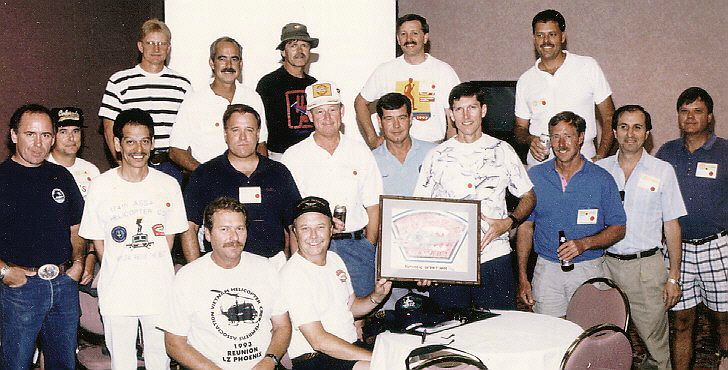
Above, several 174th members at the 1993 Phoenix reunion. Tom Taggart is
at the far left with dark T-shirt and cowboy belt buckle. To see another photo from Phoenix with
32 crewmembers and pilots, see http://www.americal.org/174/phonex-1.htm.
In this second photo, Taggart is second from the left on the top row between Danny Davidson and
webmaster Jim McDaniel.
I was surprised by the number of guys
I flew with that got into the same profession as I had, Law Enforcement. I became a Police Officer in
Billings, Montana in 1973. I have also worked for the Wyoming Highway Patrol, and finally with the
Yellowstone County Sheriff's Office, Billings, Montana where I retired in 1998. While with the Sheriff's
Office, I was in charge of a Task Force based at the DEA (Drug Enforcement Administration) office
in Billings. Through that position, I ended up working several investigations that took me to Los
Angeles, California. As luck would have it, this is where Fred Thompson lives. On each trip to LA I
would either call Fred or meet him. Fred also was in Law Enforcement and has retired from the
LAPD. I don't know if it's the same with other Assault Helicopter Companies to have a large number
of their people doing the same type of work after the military. I think it has to do with the adrenaline
rush of flying in combat and that unknown. Police work has the same type of unknown and rush
we adrenaline junkies need.
When I spoke to my mother, God rest her soul, about
these reunions, she would ask me why I will travel across country on short notice to visit these
people I only knew for a short period of time, when I haven't been to any of my high school reunions
with people I had grown up with. I told her that I have more in common with friends from Vietnam
and Laos, who I knew from only one month to a year, than I do with people I grew up with. There's
that bond between these guys, which for me is stronger than any childhood friend. That fear of
dying, and the trust and confidence that builds from knowing that the only people that can and will
help you survive are your crewmembers and wing ships.
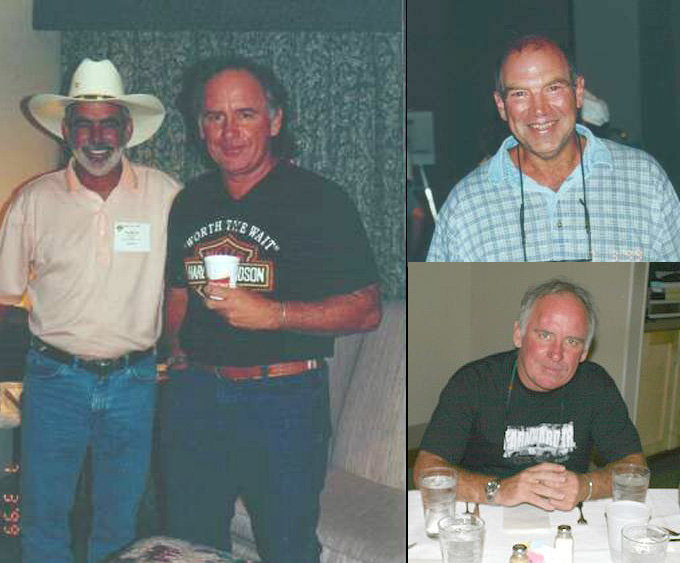
Above left: Yogi Reeves and Taggart- 1993 Phoenix. Top right: Bruce Marshall. Bottom right: Tom at the 2005 174th AHC Annual Reunion.
How do I
sum up my experiences with the 174th? I respect each and every member of that organization. At
the time Cobras were fast, sleek and armed to the teeth. But we didn't have any of those. To see a
Charlie model gunship from the ground, low level, painted with that "please shoot at me"
wrap-around grin, with its miniguns and rocket pods, reminds me of a pitbull.
That
old Charlie model may be slow and fat, but it had attitude. Most of it bad. I think the NVA/VC saw
that same attitude, which could only be personified by the crews that flew them. The crews that
flew the slicks deserve the most credit and respect, since they dealt with the day-to-day challenges
of simply surviving the hostile environments of re-supply, CAs, C&Cs, LRRP insertions and
extractions, etc., both in Vietnam and especially Laos.
And the unsung heroes who
made it all happen were the maintenance folks, rearm, armament, avionics, clerks and the rest
of the support group who, without their efforts, the 174th wouldn't have been the unit we were.
The military has its pecking order, which I understand, but in combat no one cares
what rank you are--you do what you have to do to save your crew/team, and that's what impressed
me most about the 174th. It was a team effort. The 174th motto: "Nothing Impossible" says it
all.
I have to apologize for not having the names of all the crews and support people
I have known. If I had known I was going to live this long I would've kept a diary. I have flown with
so many different pilots, crew chiefs and gunners, that after awhile they all blend together. If anyone
can fill in the blanks for the above events, either let Jim McDaniel, Warren Hewetson or myself know
.
Love ya all,
Taggart
-----------------------
Tom Taggart
788 Senora Ave.
Billings, Mt 59105
hm 406-896-0194
wk 406-256-6861
cel 406-670-4881
e-mail:
TTaggart@co.yellowstone.mt.us
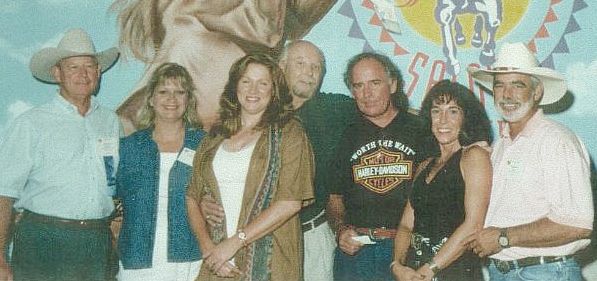
*Assistant Webmaster note: At the time Tom and we composed this, it was before our beloved Fred Thompson passed away (November 8, 2002). We all love Fred and he is sorely missed. Of course, Tom and Fred were very close.
|








